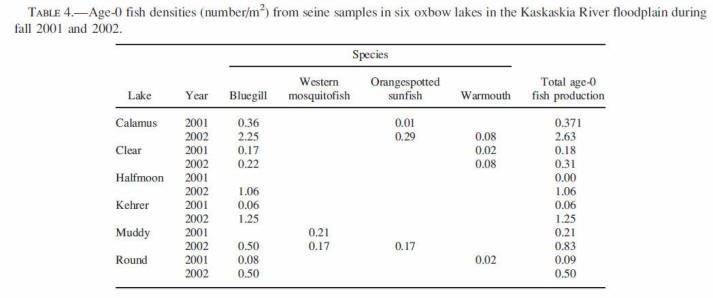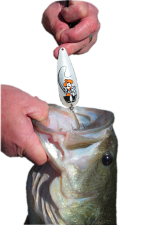Fish Diversity and Abundance in Relation to Inter-Annual and Lake-Specific Variation in Abiotic Characteristics of Floodplain Lakes of the Lower Kaskaskia River, Illinois
(Funded by Conservation 2000 funds administered through the Illinois Department of Natural Resources)
Project personnel: Dan Shoup, Dave Wahl
Shoup, D.E., and Wahl, D.H. 2009. Fish diversity and abundance in relation to interannual and lake-specific variation in abiotic characteristics of floodplain lakes of the Lower Kaskaskia River, Illinois. Transactions of the American Fisheries Society. Transactions of the American Fisheries Society. 138:1076-1092.

The importance of floodplain lakes to tropical river systems is well established, but little is known about the function of these habitats in temperate river systems. We examined fish diversity, abundance, and reproduction within six oxbow lakes of the Kaskaskia River, Illinois over 5 years and their relationship to 11 abiotic environmental variables. The lakes were hydrologically dynamic within and among years, varying in the time connected with the mainstem (0 – 22 weeks/year) and the frequency of low water (<0.3 m; occurred 0 – 23 weeks/year in the study lakes). Differences were found both among years and lakes. All measured limnological variables (dissolved oxygen, secchi depth, conductivity, and temperature) varied temporally, only conductivity and secchi depth varied among lakes. Fish species differed among lakes and between adjacent lotic habitats, and species-specific abundance varied among years, seasons, and lakes. This variation was related to several environmental variables. Diversity was positively related to distance between the oxbow lake and the river, but was not related to any variables that had inter-annual variation. Seine CPUE was negatively related to mean water level and secchi depth. Total electrofishing CPUE was not related to any variables; however, bluegill CPUE was positively related to maximum depth, and warmouth CPUE was positively related to vegetated area. Across all lakes, evidence of reproduction was found for five species and was negatively related to mean water level and frequency of low water, and positively with flood periodicity. The oxbow lakes have the potential to contribute to the fish community of the main river by providing spawning and nursery habitat for several species as well as helping maintain several less abundant main-stem species. However, when considering management options to maintain or restore these ecosystem functions, inter-annual variation in environmental variables, particularly those related to flood periodicity, should be considered.



